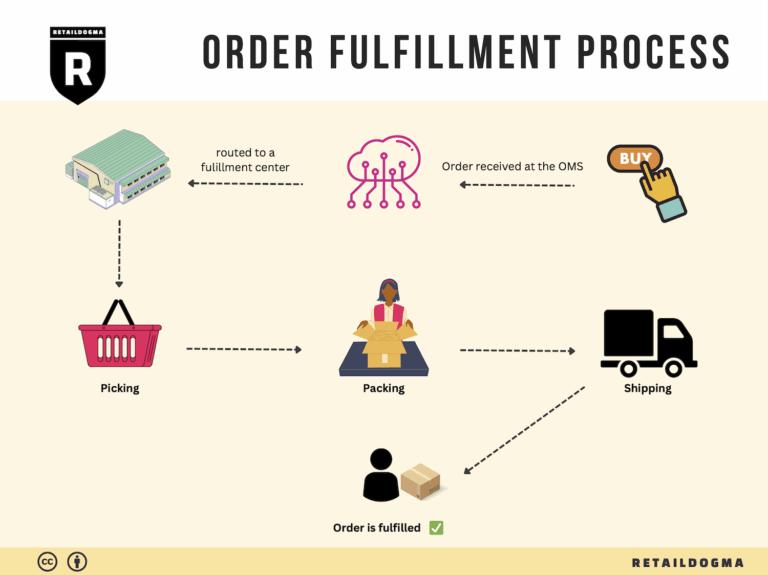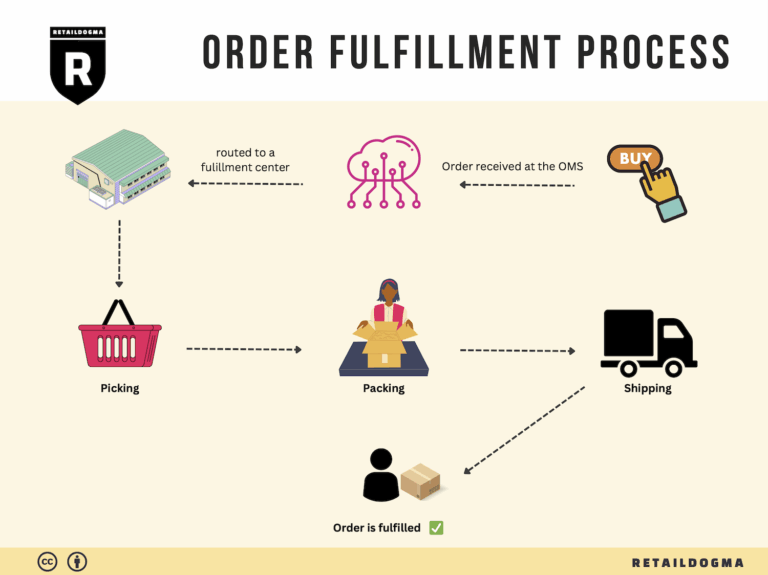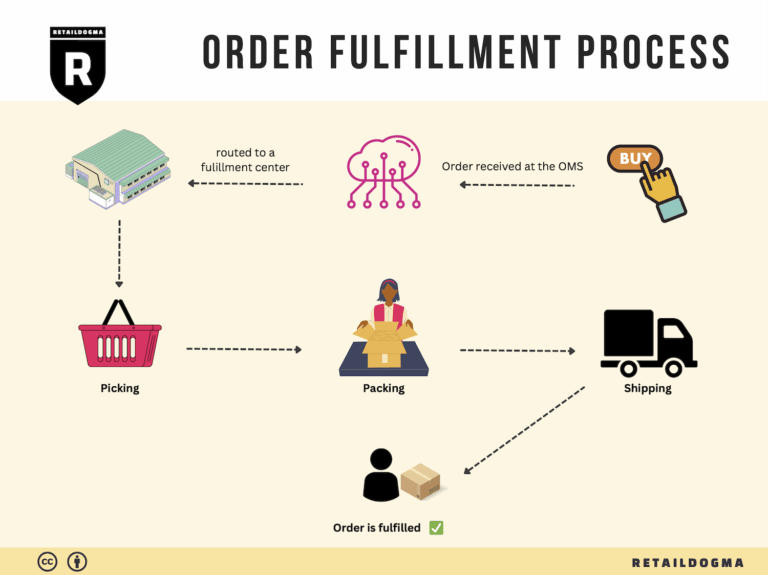Ecommerce Fulfillment Services: The Ultimate Guide (2025)
What is E-commerce Fulfillment? An Introduction for Growing Businesses
The Challenge of Order Fulfillment for Growing Businesses
For many e-commerce business owners, the excitement of increasing sales can quickly turn into stress when faced with the complexities of packing and shipping orders. As your business grows, so does the volume of orders, leading to potential overwhelm in managing logistics. The process of getting products from your inventory to your customers is known as e-commerce fulfillment, and it encompasses everything from order processing and inventory management to packaging and shipping.
Understanding E-commerce Fulfillment
At its core, e-commerce fulfillment is simply the process of getting a product to a customer. This includes picking the right items from your inventory, packing them securely, and shipping them out in a timely manner. Efficient fulfillment is crucial, as customers today expect fast and reliable delivery. In fact, many consumers cite convenience as their primary reason for shopping online, emphasizing the need for effective logistics.
What This Guide Covers
In this guide, we will explore various fulfillment models available to online businesses, including third-party logistics (3PL) providers and Fulfillment by Amazon (FBA). Each model has its unique advantages and challenges, so understanding these differences will help you select the best option for your business needs.
We will also delve into the core services associated with e-commerce fulfillment, such as inventory management, order processing, shipping logistics, and returns management. Knowing what services are available will empower you to create a streamlined and efficient fulfillment process.
Moreover, we will provide practical advice on how to choose the right fulfillment partner. Factors such as location, shipping speed, pricing structures, and customer service capabilities are essential considerations in making an informed choice.
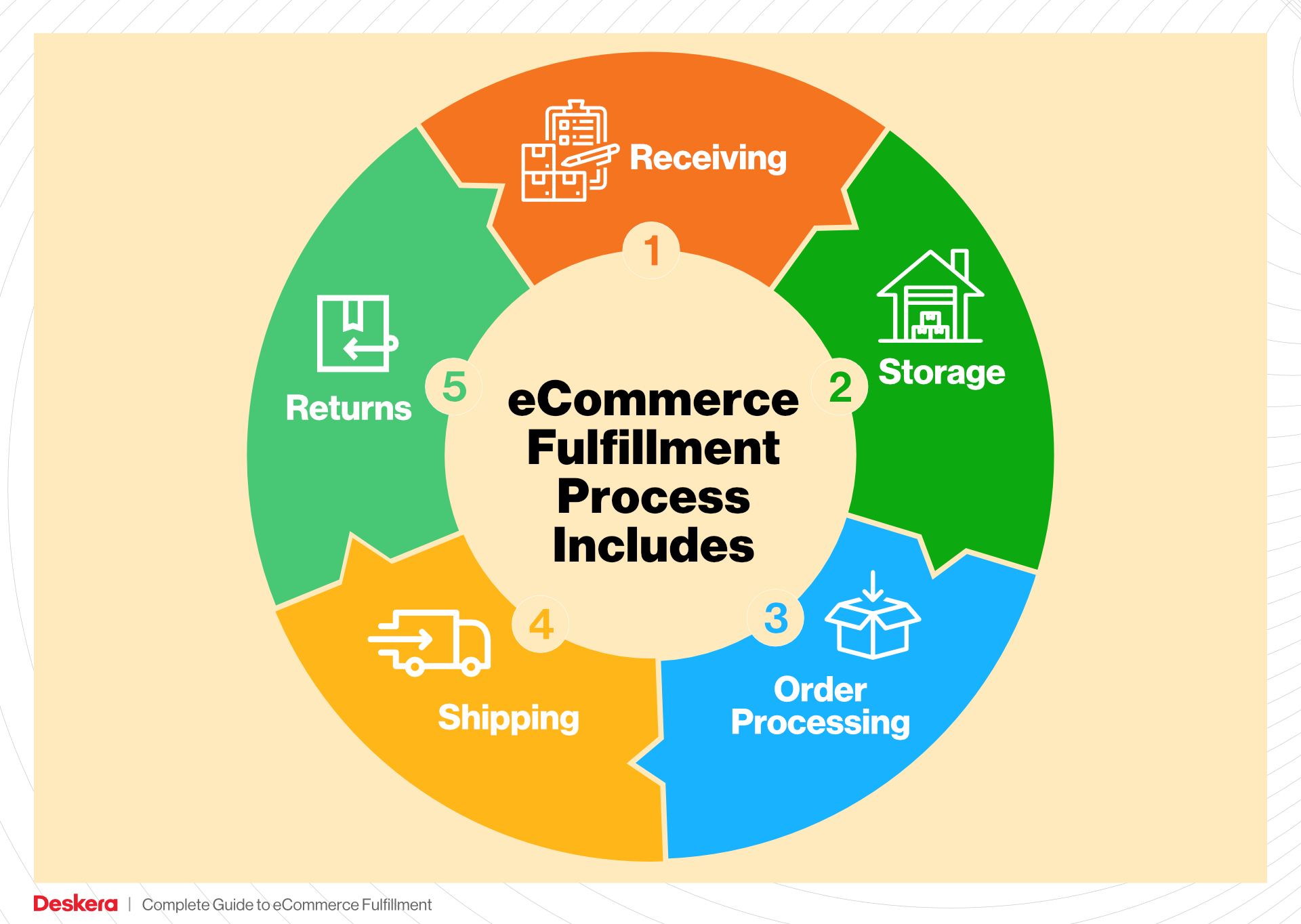
Lastly, we will break down pricing strategies for fulfillment services to help you understand the financial implications of various options. Cost-effective fulfillment can significantly impact your bottom line, and navigating these costs is vital for sustainable growth.
Empowering Smart Logistics Decisions
Ultimately, the goal of this guide is to empower e-commerce businesses to make informed decisions about their logistics. With the right fulfillment strategy in place, you can not only enhance customer satisfaction but also free up valuable time and resources to focus on scaling your business. Let’s dive deeper into the world of e-commerce fulfillment and explore how you can optimize this critical aspect of your operations.
What You’ll Learn In This Guide
- What is E-commerce Fulfillment? An Introduction for Growing Businesses
- The Order Fulfillment Process: From ‘Buy’ Button to Customer’s Door
- Comparing Fulfillment Models: In-House vs. 3PL vs. Dropshipping
- A Deep Dive into Amazon FBA: Pros, Cons, and Who It’s For
- Core Services Offered by Fulfillment Centers
- How to Choose a Fulfillment Partner: A 6-Point Checklist
- Understanding Fulfillment Pricing: A Breakdown of Common Fees
- Frequently Asked Questions (FAQs) about Fulfillment
- Conclusion: Is Outsourcing Fulfillment the Right Move for Your Business?
- Important Disclaimer
The Order Fulfillment Process: From ‘Buy’ Button to Customer’s Door
1. Receiving Inventory
The first step in the order fulfillment process is receiving inventory. This involves accepting shipments of products from suppliers or manufacturers and ensuring that the delivered items match the purchase order. During this phase, businesses should verify the quantity and condition of the products, often using Stock Keeping Units (SKUs) to track items accurately.
Importance: Efficient inventory receiving is crucial because it sets the foundation for the entire fulfillment process. Any discrepancies in this stage—such as damaged goods or incorrect quantities—can lead to delays and complications further down the line, impacting customer satisfaction.
Key Term: SKU (Stock Keeping Unit) – A unique identifier for each product, essential for inventory management and tracking.
2. Warehouse Storage
Once inventory is received, the next step is warehouse storage. This process involves categorizing and organizing products within the warehouse to optimize space and improve retrieval efficiency. Depending on the fulfillment strategy, items may be stored in various ways: bulk storage for large quantities, shelf storage for smaller items, or even temperature-controlled storage for perishable goods.
Importance: Proper warehouse storage is vital for minimizing the time spent locating items when orders are placed. An organized warehouse not only speeds up the order picking process but also reduces the likelihood of errors, such as shipping the wrong item or miscounting inventory.
Key Term: FIFO (First In, First Out) – A method used to manage inventory where the oldest stock is sold first, which is particularly important for perishable goods.
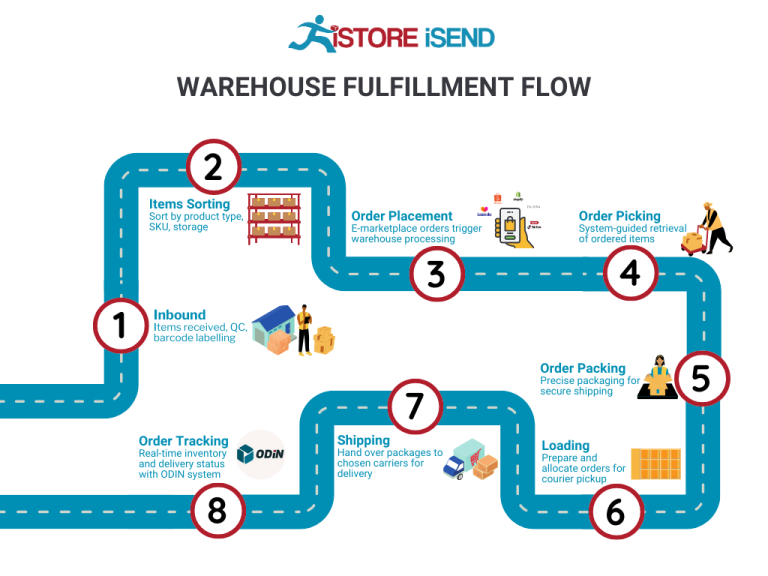
3. Order Picking
Order picking is the process of retrieving items from storage based on customer orders. This step typically involves creating a pick list, which is a document that outlines the items and quantities needed for each order. Warehouse staff will then use this list to navigate the storage area and collect the necessary products.
Importance: Efficient order picking is critical to maintaining fast fulfillment times. The quicker and more accurately items can be picked, the sooner they can be packed and shipped. Implementing technologies such as barcode scanning or pick-to-light systems can significantly enhance the speed and accuracy of this process.
Key Term: Pick List – A document or digital tool used to guide warehouse workers in selecting the right products for each order.
4. Order Packing
After items are picked, they move to the order packing stage. This involves carefully packaging the products to ensure they arrive safely at the customer’s door. During packing, businesses should consider factors such as the type of packaging material, cushioning to prevent damage, and labeling for shipping.
Importance: Effective packing not only protects the products during transit but also enhances the customer experience. A well-packaged order reflects professionalism and care, contributing to customer satisfaction and loyalty. Additionally, using the right packing materials can help reduce shipping costs by minimizing weight and size.
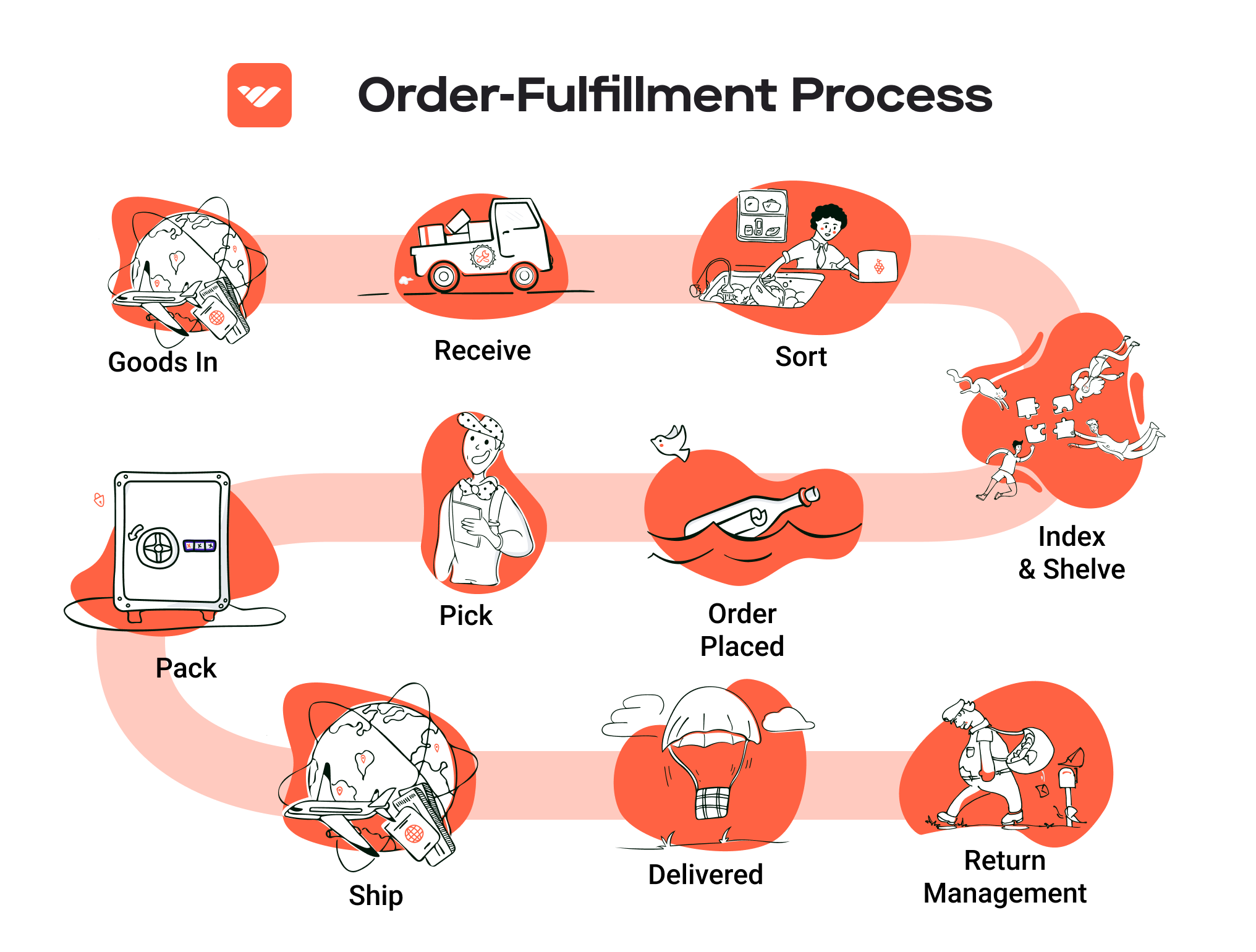
Key Term: Packing Slip – A document included with the shipment that lists the items enclosed, providing transparency and helping customers verify their order.
5. Shipping & Delivery
The final step in the order fulfillment process is shipping and delivery. This involves selecting a shipping carrier, generating shipping labels, and dispatching the packaged orders to customers. Businesses need to consider various shipping options, such as standard, expedited, or international shipping, to meet customer expectations.
Importance: Timely shipping is a significant factor in customer satisfaction. With the growing demand for fast delivery, businesses must choose carriers that can meet their delivery promises. Efficient shipping also involves tracking orders so that both the business and the customer can monitor the shipment’s progress.
Key Term: Last-Mile Delivery – The final leg of the shipping process where the order is delivered from a transportation hub to the customer’s doorstep, often considered the most critical and costly part of logistics.
By understanding and optimizing each step of the order fulfillment process, e-commerce businesses can enhance operational efficiency, reduce costs, and ultimately deliver a superior customer experience.
Comparing Fulfillment Models: In-House vs. 3PL vs. Dropshipping
Fulfillment Model Comparison Table
| Model | Who Handles Inventory | Best For (Business Stage) | Key Advantage | Key Disadvantage |
|---|---|---|---|---|
| In-House Fulfillment | The business itself | Startups and small businesses | Complete control over inventory and processes | Higher operational costs and resource requirements |
| Third-Party Logistics (3PL) | A third-party fulfillment provider | Growing businesses with scaling needs | Cost efficiency and access to expertise | Less control over fulfillment processes and inventory |
| Dropshipping | Supplier or manufacturer | New businesses with limited funds | Low upfront costs and minimal risk | Reduced control over shipping times and product quality |
In-House Fulfillment
In-house fulfillment refers to the process where an e-commerce business manages its own inventory, packing, and shipping operations. This model is particularly beneficial for startups and small businesses that may have unique shipping needs or wish to maintain complete control over their inventory and order fulfillment processes. By handling fulfillment in-house, businesses can ensure high-quality packaging, personalized customer service, and quicker response times to any issues that arise. However, this model comes with its own set of challenges. It often requires a significant investment in warehousing, staffing, and technology, which can lead to higher operational costs. Additionally, as the business scales, managing increased order volumes can become cumbersome and resource-intensive. Therefore, while in-house fulfillment provides control and flexibility, it may not be sustainable for businesses with plans for rapid growth.
Third-Party Logistics (3PL)
Third-party logistics (3PL) is a fulfillment model where businesses outsource their warehousing, inventory management, and shipping operations to specialized fulfillment providers. This model is ideal for growing businesses that experience increasing order volumes and require a scalable solution without the overhead costs associated with in-house fulfillment. By partnering with a 3PL provider, e-commerce companies can benefit from reduced shipping costs, access to advanced logistics technology, and expertise in inventory management. 3PL providers often operate fulfillment centers strategically located to optimize shipping times and costs. However, the trade-off is a potential loss of control over the fulfillment process. Businesses must rely on their 3PL partner to maintain inventory levels, manage shipping logistics, and handle customer service issues, which can lead to inconsistencies if not managed carefully. Overall, while 3PL can significantly enhance efficiency and scalability, businesses need to choose their partners wisely to ensure alignment with their operational standards and customer expectations.
Dropshipping
Dropshipping is a fulfillment model that allows e-commerce businesses to sell products without holding inventory. Instead, when a business receives an order, it forwards the order details to a manufacturer or supplier, who then ships the product directly to the customer. This model is particularly appealing for new entrepreneurs or businesses with limited funds since it requires minimal upfront investment and eliminates the need for warehousing space. Dropshipping enables businesses to offer a wide range of products without the associated risks of unsold inventory. However, it also comes with its disadvantages. The primary concern for dropshippers is the lack of control over shipping times and product quality, as these factors are dependent on the supplier’s performance. Additionally, businesses may face challenges related to customer service, as any issues with fulfillment can reflect poorly on the retailer, even if they are not directly responsible. While dropshipping can be an excellent way to enter the e-commerce market, it is crucial for entrepreneurs to vet suppliers carefully and understand the implications of relying on third parties for order fulfillment.
A Deep Dive into Amazon FBA: Pros, Cons, and Who It’s For
Understanding Fulfillment by Amazon (FBA)
Fulfillment by Amazon (FBA) is a service provided by Amazon that allows e-commerce sellers to store their products in Amazon’s fulfillment centers. When a customer places an order, Amazon takes care of storage, packaging, and shipping on behalf of the seller. This service is particularly attractive for businesses looking to scale quickly and efficiently, leveraging Amazon’s vast logistics network and customer base.
How FBA Works
-
Inventory Preparation and Shipping: Sellers send their products to Amazon’s fulfillment centers. It’s crucial to prepare the inventory according to Amazon’s guidelines, which include labeling and packaging requirements.
-
Storage: Once the inventory is received, Amazon stores the products in its warehouses. Sellers can track their inventory levels through the Amazon Seller Central dashboard.
-
Order Processing: When a customer places an order, Amazon picks, packs, and ships the product directly to the customer. This process is designed to be efficient, often with orders shipped within hours of being placed.
-
Customer Service and Returns: Amazon also handles customer service inquiries related to the orders and manages returns, providing a seamless experience for customers and reducing the burden on sellers.
-
Fees: Sellers pay various fees for using FBA, including storage fees for the inventory stored in Amazon’s warehouses and fulfillment fees based on the size and weight of the products shipped.
Pros of FBA
1. Prime Eligibility
One of the most significant advantages of using FBA is that products become eligible for Amazon Prime. This means that Prime members can receive free two-day shipping, which significantly enhances the attractiveness of your products. Being part of the Prime ecosystem can lead to increased visibility and sales, as many customers filter their searches to show only Prime-eligible items.
2. Customer Trust
Amazon is a globally recognized brand, and customers trust it for its reliable service and efficient delivery. By using FBA, sellers can leverage this trust, as customers often feel more secure purchasing from sellers who use Amazon’s fulfillment services. This trust can lead to higher conversion rates and repeat purchases.
3. Multi-Channel Fulfillment
FBA allows sellers to fulfill orders not only from Amazon but also from other sales channels, such as their own e-commerce websites or other marketplaces. This multi-channel fulfillment capability enables businesses to streamline their logistics and inventory management processes, creating a cohesive experience across different sales platforms.
4. Efficient Returns Management
Amazon’s robust returns process simplifies the handling of returns for sellers. Customers can initiate returns through their Amazon accounts, and Amazon manages the entire process. This efficiency can enhance customer satisfaction and loyalty.
5. Scalable Operations
As businesses grow, managing logistics in-house can become overwhelming. FBA allows sellers to scale their operations without the need to invest in additional warehouse space, staff, or shipping infrastructure. This scalability is crucial for businesses aiming for rapid growth.
Cons of FBA
1. High Fees
While FBA offers numerous benefits, it also comes with significant costs. Sellers must pay for storage fees, which can increase during peak seasons, as well as fulfillment fees based on the size and weight of their products. For some sellers, especially those with low margins, these fees can eat into profits.
2. Strict Inventory Rules
Amazon has stringent inventory management rules that sellers must adhere to. This includes limits on the number of units that can be sent to fulfillment centers, the requirement to maintain inventory levels, and the need to manage stock efficiently. Failure to comply can result in penalties or even account suspensions.
3. Commingling Risks
FBA uses a commingling method for inventory, where products from different sellers are stored together. This can pose risks for sellers, as they may receive returns or damaged items that were actually sent by other sellers. This lack of control can lead to customer dissatisfaction and potential damage to a seller’s reputation.
4. Loss of Control Over Branding
When using FBA, sellers lose some control over the customer experience, particularly in packaging and branding. Amazon’s standardized packaging may not align with a seller’s brand identity, which can be a disadvantage for businesses that prioritize branding and customer experience.
5. Competition with Amazon
Sellers using FBA are often competing against Amazon itself, which can offer similar products at competitive prices. This competition can make it challenging for smaller sellers to gain visibility and sales.
Who is FBA Best For?
FBA is best suited for sellers who want to leverage Amazon’s extensive logistics network and customer base without the overhead costs of managing their own fulfillment operations. It is particularly beneficial for:
-
High-Volume Sellers: Businesses that sell a large volume of products and can afford the associated fees will find FBA to be a cost-effective solution.
-
New Sellers: New e-commerce entrepreneurs can benefit from FBA’s streamlined process and customer trust, allowing them to focus on marketing and product development rather than logistics.
-
Brands Seeking National Reach: Sellers who want to reach customers across the country without investing in their own shipping infrastructure will find FBA advantageous.
-
Multi-Channel Retailers: Businesses that sell on multiple platforms and want a unified fulfillment strategy can take advantage of FBA’s multi-channel fulfillment capabilities.
In summary, while FBA offers many advantages that can help businesses scale quickly, it is essential for sellers to carefully weigh the pros and cons to determine if it aligns with their business model and growth objectives.
Core Services Offered by Fulfillment Centers
Inventory Management & Warehousing
Inventory management and warehousing form the backbone of any fulfillment center’s operations. This service encompasses the systematic control of stock levels, storage, and the overall organization of products within the fulfillment center.
What It Is:
Fulfillment centers utilize sophisticated inventory management systems that track stock levels in real-time, allowing businesses to maintain optimal inventory levels. This includes receiving shipments, storing products in designated areas, and conducting regular audits to ensure accuracy.
Benefits to E-Commerce Businesses:
1. Reduced Overhead Costs: By outsourcing inventory storage, e-commerce businesses can avoid the significant costs associated with maintaining their own warehouses, including rent, utilities, and staffing.
2. Scalability: As sales increase, fulfillment centers can easily accommodate growing inventory needs without the hassle of relocating or expanding a physical space.
3. Improved Accuracy: Advanced inventory management systems reduce the risk of errors in stock counts, leading to fewer stockouts and overstock situations. This accuracy enhances customer satisfaction by ensuring that products are available for prompt shipping.
Pick and Pack Services
Pick and pack services are critical for the efficient processing of orders in fulfillment centers. This service involves selecting items from inventory (picking) and packaging them for shipment (packing).
What It Is:
Once an order is placed, fulfillment center staff retrieve the items from their storage locations and prepare them for shipment. This process often involves custom packaging solutions to ensure products are protected during transit.
Benefits to E-Commerce Businesses:
1. Speed and Efficiency: Fulfillment centers employ trained staff and optimized workflows to ensure orders are processed quickly, often within hours of receipt. This speed is crucial for meeting customer expectations for fast delivery.
2. Quality Control: Many fulfillment centers implement quality checks during the pick and pack process to ensure that the correct items are shipped, reducing the likelihood of returns and enhancing customer satisfaction.
3. Custom Packaging Options: Businesses can take advantage of tailored packaging solutions that reflect their brand identity, enhancing the unboxing experience for customers and potentially increasing brand loyalty.
Kitting and Assembly
Kitting and assembly services allow businesses to create bundled products or kits, which can be a strategic way to increase sales and improve customer satisfaction.
What It Is:
This service involves assembling multiple products into a single package or kit, which can include a combination of items sold together, promotional bundles, or gift sets. Fulfillment centers handle the logistics of assembling these kits and managing inventory for the individual components.
Benefits to E-Commerce Businesses:
1. Increased Sales Opportunities: By offering bundled products, businesses can encourage customers to purchase more items at once, increasing the average order value.
2. Streamlined Operations: Outsourcing kitting and assembly allows businesses to focus on core operations, such as marketing and product development, rather than the labor-intensive process of assembling kits.
3. Flexibility and Customization: Fulfillment centers can quickly adapt to changes in demand for specific kits or products, allowing businesses to respond to market trends without the need for significant reconfiguration of their operations.
Returns Management (Reverse Logistics)
Returns management, often referred to as reverse logistics, is a crucial service provided by fulfillment centers that focuses on handling returned items efficiently and effectively.
What It Is:
This service involves processing returns from customers, inspecting items for damage, restocking inventory, and managing the resale of returned products. Fulfillment centers have established processes to streamline this often-complex operation.
Benefits to E-Commerce Businesses:
1. Enhanced Customer Satisfaction: A seamless returns process can significantly improve customer trust and satisfaction, encouraging repeat purchases. Customers appreciate easy return policies and prompt processing of their refunds or exchanges.
2. Cost Efficiency: By outsourcing returns management, businesses can reduce the overhead associated with handling returns in-house, such as staffing and storage for returned items.
3. Data Insights: Fulfillment centers can provide valuable insights into return trends, helping businesses understand product performance and customer preferences. This data can inform future product development and inventory strategies.
In summary, partnering with a fulfillment center offers e-commerce businesses a suite of essential services designed to optimize inventory management, streamline order processing, enhance customer satisfaction, and ultimately drive growth. By leveraging these services, businesses can focus on scaling their operations while ensuring a high-quality experience for their customers.
How to Choose a Fulfillment Partner: A 6-Point Checklist
Location & Warehouse Network
Importance: The geographical location of your fulfillment partner’s warehouses is crucial for ensuring fast shipping and reducing transit times. A well-distributed warehouse network allows you to reach your customers more efficiently, which can lead to higher satisfaction rates and repeat business.
Questions to Ask:
– Where are your fulfillment centers located, and how does this affect shipping times to my primary customer base?
– How do you manage inventory across multiple locations?
– Do you have the capability to store products in regions that can serve my target markets more effectively?
Technology & Integrations
Importance: Efficient order fulfillment relies heavily on technology. Your fulfillment partner should offer robust software solutions that integrate seamlessly with your e-commerce platform, inventory management systems, and other tools you use. This ensures real-time tracking, accurate inventory levels, and streamlined operations.
Questions to Ask:
– What technology do you use for order management and inventory tracking?
– Can your system integrate with my current e-commerce platform (e.g., Shopify, WooCommerce)?
– Do you provide real-time reporting and analytics, and how can I access this data?
Specializations (e.g., cold storage, oversized items)
Importance: Different businesses have unique needs based on the nature of their products. If you sell perishable goods, fragile items, or oversized products, it’s essential to partner with a fulfillment provider that has the necessary capabilities and expertise.
Questions to Ask:
– Do you have specialized facilities for handling specific types of products (e.g., cold storage for food items, secure storage for high-value items)?
– What experience do you have in handling products similar to mine?
– Can you accommodate unique packaging or shipping requirements for my products?
Scalability & Capacity
Importance: As your business grows, your fulfillment needs will evolve. A good fulfillment partner should be able to scale operations in line with your growth, whether you’re expanding your product line, entering new markets, or experiencing seasonal spikes in demand.
Questions to Ask:
– How quickly can you scale operations to accommodate increased order volume?
– Do you have the capacity to handle peak seasons or promotional events?
– What is your process for managing inventory fluctuations, and how do you ensure I have enough stock available during busy periods?
Pricing and Contracts
Importance: Understanding the pricing structure and contract terms is vital to ensure you’re getting value for your money. Hidden fees can significantly impact your bottom line, so clarity in pricing is essential.
Questions to Ask:
– What is your pricing model (e.g., per order, per item, monthly storage fees)?
– Are there any additional fees I should be aware of (e.g., for returns, special handling, or seasonal surcharges)?
– What are the contract terms, and is there flexibility for scaling up or down based on my needs?
Customer Support & Reviews
Importance: Exceptional customer support can make a significant difference in your fulfillment experience. Issues will arise, and having a responsive partner is essential to resolving them quickly. Additionally, reviews and testimonials can provide insight into a partner’s reliability and service quality.
Questions to Ask:
– What type of customer support do you offer (e.g., dedicated account manager, 24/7 support)?
– How do you handle issues or discrepancies in orders?
– Can you provide references or case studies from similar businesses that have worked with you?
Conclusion
Choosing the right fulfillment partner is a critical decision that can affect your e-commerce operations, customer satisfaction, and overall business success. By using this checklist, you can systematically evaluate potential partners, ensuring they align with your business needs and growth ambitions. Take the time to ask these questions and assess their responses, as a strategic partnership in fulfillment can drive your business to new heights.
Understanding Fulfillment Pricing: A Breakdown of Common Fees
Initial Setup Fees
When partnering with a fulfillment provider, many businesses encounter initial setup fees. These fees cover the onboarding process, which may include the integration of your e-commerce platform with the fulfillment center’s systems, inventory setup, and configuration of shipping options. The costs can vary significantly based on the complexity of your needs, ranging from a few hundred to several thousand dollars.
To calculate these fees, fulfillment centers typically assess the following:
- Integration Requirements: The level of technical integration needed to connect your online store with their systems.
- Inventory Setup: The time and resources required to catalog and store your products in their warehouse.
- Training and Support: Any initial training sessions or ongoing support to help you navigate their systems.
Receiving Fees
Receiving fees are charged when your inventory arrives at the fulfillment center. This fee covers the labor and resources needed to unload, inspect, and store your products. Receiving fees can vary based on the volume of inventory and the complexity of the items (e.g., fragile items may require more handling).
Typically, receiving fees are calculated based on:
- Per Pallet or Case: Many fulfillment centers charge a flat fee for each pallet or case received. This fee can range from $25 to $100, depending on the provider.
- Inspection Costs: If your products require quality checks or specific handling upon arrival, additional charges may apply.
Storage Fees (per pallet/bin)
Storage fees are recurring charges for the space your inventory occupies within the fulfillment center. These fees can be structured in several ways, but are commonly calculated on a per pallet or per cubic foot basis.
Key considerations for storage fees include:
- Monthly Fees: Most fulfillment centers charge a monthly fee per pallet or bin stored, which can range from $10 to $50 per pallet depending on the warehouse location and service level.
- Seasonal Adjustments: Some providers may implement higher rates during peak seasons (e.g., holidays) when demand for storage space increases.
Pick & Pack Fees (per item/order)
Pick and pack fees are incurred each time an order is processed. This fee covers the labor required to retrieve items from storage, package them, and prepare them for shipment. The complexity of your order can influence the cost; for example, orders with multiple items may incur higher fees than single-item orders.
These fees are typically calculated based on:
- Per Item: Many fulfillment centers charge a fee for each item picked and packed, which can range from $0.50 to $3.00 per item.
- Per Order: Some providers charge a flat fee per order, regardless of the number of items included, which can range from $1.50 to $5.00.
Shipping Fees
Shipping fees are perhaps the most variable component of fulfillment pricing, as they depend on numerous factors such as package weight, dimensions, destination, and shipping speed. Fulfillment centers negotiate rates with carriers, which can affect the final shipping costs passed on to you.
Shipping fees are typically calculated based on:
- Carrier Rates: The cost charged by the shipping carrier based on the service level selected (e.g., standard, expedited).
- Dimensional Weight: Some carriers calculate shipping fees based on dimensional weight, which takes into account the size of the package rather than just its weight.
- Zone Pricing: Shipping costs can vary based on distance from the fulfillment center to the customer, with different zones often resulting in different rates.
Tips for Getting an Accurate Quote
-
Provide Detailed Information: When requesting quotes, offer detailed information about your products, order volume, and shipping needs. This will enable providers to give more accurate estimates.
-
Ask About Hidden Fees: Inquire about any additional fees that may not be included in the initial quote, such as returns processing or special handling charges.
-
Compare Multiple Providers: Don’t settle for the first quote you receive. Compare several fulfillment centers to understand the range of services and pricing structures available.
-
Consider Future Needs: Factor in potential growth when evaluating quotes. A provider that meets your current needs may not be able to scale with you, leading to higher costs later on.
-
Negotiate Terms: Many fulfillment centers are open to negotiating terms, especially if you can commit to a longer-term contract or higher volume of orders.
By understanding these common fees and how they are calculated, you can better evaluate fulfillment providers and choose one that aligns with your business goals.
Frequently Asked Questions (FAQs) about Fulfillment
1. What is ecommerce fulfillment?
Ecommerce fulfillment is the comprehensive process of receiving, processing, and delivering online orders. It includes managing inventory, picking and packing products, and coordinating shipping logistics to ensure timely delivery to customers.
2. How do I fulfill an ecommerce order?
You can fulfill ecommerce orders in several ways:
– Self-fulfillment: Manage your inventory and shipping in-house, ideal for small businesses with low order volumes.
– Third-party fulfillment: Partner with a fulfillment service provider to handle order processing, packing, and shipping as your business scales.
– Dropshipping: Forward orders directly to a manufacturer or distributor, who ships products directly to customers, eliminating the need for inventory management.
3. What’s the difference between a warehouse and a fulfillment center?
A warehouse primarily serves as a storage space for goods, focusing on inventory management and bulk storage. In contrast, a fulfillment center is specifically designed for order processing, including picking, packing, and shipping products directly to customers. Fulfillment centers are typically strategically located to optimize shipping times.
4. What is a 3PL?
A 3PL, or third-party logistics provider, is a company that offers outsourced logistics services, including warehousing, inventory management, order fulfillment, and shipping. Businesses often partner with 3PLs to streamline operations and reduce costs as they scale.
5. How much do fulfillment services cost?
Costs for fulfillment services can vary widely based on factors such as order volume, storage needs, and shipping methods. Typically, you may encounter charges for storage space (per cubic foot), order processing (per order or per item), and shipping (based on weight and distance). It’s essential to obtain quotes from various providers to find the best fit for your budget.
6. What factors should I consider when choosing a fulfillment provider?
When selecting a fulfillment provider, consider the following:
– Location: Proximity to your customer base can reduce shipping times.
– Technology: Look for providers with robust inventory management systems that integrate with your ecommerce platform.
– Scalability: Ensure the provider can accommodate your growth and handle peak seasons.
– Cost structure: Understand their pricing model to avoid hidden fees.
– Customer service: Reliable support is essential for resolving issues quickly.
7. How can I improve my order fulfillment speed?
To enhance order fulfillment speed, consider these strategies:
– Optimize inventory management: Maintain accurate stock levels and automate inventory tracking.
– Leverage multiple fulfillment centers: Use centers closer to your customers to reduce shipping times.
– Streamline packing processes: Implement efficient packing methods and train staff for quick order processing.
– Utilize technology: Invest in fulfillment software that automates tasks and improves order accuracy.
8. What are the benefits of using a fulfillment service?
Utilizing a fulfillment service can offer numerous advantages:
– Cost savings: Benefit from bulk shipping rates and reduced overhead costs.
– Time efficiency: Free up time to focus on marketing and growing your business.
– Scalability: Easily adapt to fluctuating order volumes without investing in additional infrastructure.
– Enhanced customer experience: Improve delivery times and order accuracy, leading to higher customer satisfaction.
9. How do I manage returns in ecommerce fulfillment?
Effective return management involves establishing a clear return policy, using a dedicated returns management system, and communicating with customers throughout the process. Partnering with a fulfillment provider that offers returns processing can streamline this aspect, ensuring that returned items are handled quickly and efficiently.
10. Can I fulfill orders internationally?
Yes, many fulfillment providers offer international shipping options. When fulfilling orders internationally, it’s crucial to understand customs regulations, tariffs, and shipping costs. Choose a provider experienced in global logistics to ensure smooth delivery across borders and compliance with international trade laws.
Conclusion: Is Outsourcing Fulfillment the Right Move for Your Business?
Evaluating the Benefits of Outsourcing Fulfillment
Outsourcing your fulfillment can be a transformative decision for your e-commerce business. By leveraging a fulfillment partner, you can save valuable time that would otherwise be spent managing inventory, packing orders, and coordinating shipping logistics. This allows you to focus on core business activities like product development, marketing, and customer engagement, ultimately driving growth.
One of the most significant advantages of partnering with a fulfillment service is scalability. As your order volume increases, a third-party logistics provider can easily adjust to meet your needs without the headaches of expanding your in-house operations. This flexibility enables you to respond to market demands swiftly, ensuring that you can seize opportunities as they arise.
Moreover, fulfillment partners bring specialized expertise to the table. They are equipped with advanced technology and industry knowledge that can optimize shipping routes, reduce costs, and improve delivery times. With their established networks and systems, you can enhance your customer experience, which is crucial in a competitive e-commerce landscape where convenience is paramount.
However, choosing the right fulfillment partner is critical to reaping these benefits. Take the time to assess potential providers based on their capabilities, locations, and customer service. A misalignment could hinder your growth rather than facilitate it.
Next Steps
To determine if outsourcing fulfillment is the right move for your business, conduct a thorough audit of your current shipping processes. Analyze your order volume, shipping times, and associated costs. This evaluation will help you identify inefficiencies and opportunities for improvement. If you find that your operations are stretched thin or that customer expectations are not being met, it may be time to consider a fulfillment partner.
Start exploring your options today to set your business on a path to streamlined operations and enhanced customer satisfaction.
Important Disclaimer
⚠️ Important Disclaimer
The information in this guide is for educational purposes. Fulfillment services, pricing, and platform features change frequently. Always conduct your own due diligence and consult with providers directly before making business decisions.




